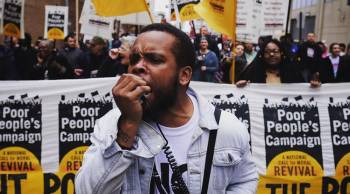
This is just one of the stories from our “I’ve Always Wondered” series, where we tackle all of your questions about the world of business, no matter how big or small. Ever wondered if recycling is worth it? Or how store brands stack up against name brands? Check out more from the series here.
Paul Kim asks: What are the salaries of religious leaders?
God can forgive our sins, it is written, but he can’t forgive our student loans.
Just like the rest of the workforce, members of the clergy have bills to pay, and in the pursuit of a role serving their faith community, those bills might include tuition.
The mean hourly wage for clergy in the United States stood at $28.93 as of May 2022, the date of the latest information from the Bureau of Labor Statistics. Those employees’ mean annual compensation was $60,180.
The BLS defines clergy as people who “conduct religious worship and perform other spiritual functions associated with beliefs and practices of religious faith or denomination.” The BLS includes imams, priests and rabbis as examples, although one imam told us that an imam is technically not a cleric.
These are averages, and factors like the clergy member’s geographic location, the size of the congregation or community they serve, and the number of years of experience they have can influence how much they are paid.
Like other professions, there are complications in the personnel pipeline, with some religions facing a shortage of future clergy or a mismatch between the roles offered and those in demand. And like other members of the labor force, aspiring religious leaders might have to contend with the cost of their education. Rabbinical school, for instance.
“In the world of work, people want to work from home, people want to have flexible schedules, people want to make sure they’re being paid what they’re worth and can do things like pay back their student loans, purchase a home and have children,” said Rabbi Elyse Wechterman, CEO of the Reconstructionist Rabbinical Association. “All of those issues confronting the American workforce are also coming to play in the clergy and rabbinic workforce.”
We spoke to leaders from a range of faiths to get a sense of how much religious figures are paid, the benefits they receive, and the investment it takes to answer a spiritual calling.
Catholic priests
A parish priest might typically make $40,000 and receive room and board, an allowance and other perks, said the Rev. Stephen Newton, executive director of the Association of U.S. Catholic Priests.
Newton said pay can depend on factors like whether one is a pastor or an associate pastor and the number of years ordained
The number of Catholic priests in the U.S. has declined from more than 59,000 in 1965 to about 34,000 in 2022, a 40%-plus loss, according to data from Georgetown University’s Center for Applied Research in the Apostolate.
Newton said the decline has been fueled by numerous factors, including the wider number of career options for educated people and the requirement that priests “must be male, celibate, single.”
The Rev. Mike Bausch, who recently retired from the Diocese of Rochester, New York, said he was making about $51,000 by the time he left three years ago. At that point, he had been ordained 42 years. On top of that, he would receive a $3,500 professional allowance, which he could use on retreats and conferences, a $4,000 table allowance, which he could use for basic necessities such as food, and a car mileage allowance to visit hospitals, parishioners and other parish-related ministries.
“I’m living comfortably, not extravagantly. Over the years, I invested in property, so I have my own house that I live in, and I take a couple decent vacations during the course of the year,” Bausch said.
In retirement, Bausch gets a pension from the diocese and medical benefits too.
His duties as priest included overseeing the finances of his parish and the parish staff, providing general counseling, helping couples prepare for marriage, and administering the sacraments. He also connected with the community, meeting people where they were by visiting their homes, having dinner or even a cocktail with them.
Islamic imams
Imam Nasir Abdussalam of the Islamic Association of West Virginia told us that imams can make anywhere from $40,000 to more than $100,000 annually, depending on the economic status of their congregants.
“The salary is going to reflect the level of income of the majority of the people who attend the mosque,” said Abdussalam, who explained that salaries are funded through community donations.
He also receives health care and retirement benefits on top of his salary. “But I’m blessed. Not every imam is in the same situation,” he said.
The duties of an imam include leading prayers, teaching classes, giving weekly sermons, visiting the sick and providing counseling and advice, Abdussalam said.
He said most mosques in the U.S. will look for imams who have memorized a large portion of the Quran and can recite it well. “They would prefer people who had a degree in Islamic law or a related field. But the situation on the ground is that we have more mosques than we have imams,” Abdussalam said.
What that means is those who lead a prayer might be a physician, engineer or businessman, he added. In some cases, an imam might not be properly educated.
“True Islamic knowledge comes from traditional study, where you sit with what’s called a sheikh, which is literally an elder, somebody who can mentor you. And you accompany that person, like an apprentice, but you’re learning law, or you’re learning theology, or you’re learning the Quran, how to explain the Quran, or learning different traditions from the Prophet Muhammad. So that’s not the regular university degree,” Abdussalam said.
Mosques seek out those who were born and raised in America, he added, but it’s hard to find American experts in Islam.
“I was fortunate enough to have a scholarship to study abroad,” said Abdussalam, who was born and raised in the U.S.
Jewish rabbis
Reform Judaism is the largest Jewish denomination, with 33% of adults who are Jewish (or were raised as Jewish) identifying as Reform Jews, according to a 2020 poll from the Pew Research Center.
The Central Conference of American Rabbis, a Reform organization, and the Union for Reform Judaism released a report in July that examined compensation for rabbis who are members of CCAR.
The report showed that the median salary for a senior or solo rabbi who served a congregation of 150 people or fewer was more than $110,000, while the median was $334,000 for rabbis who served congregations of 1,801 and over.
Some rabbinical groups that represent different denominations have far fewer members. The Reconstructionist Rabbinical Association, for one, has 380, according to CEO Elyse Wechterman.
Wechterman said RRA rabbis work at various organizations and institutions, including nonprofits, college campuses and as hospital chaplains. “We recommend that the starting salary for a new rabbi out of school at a full-time congregation is $90,000 a year,” she said, although small congregations may pay less.
However, the most experienced rabbis at larger congregations could be making $150,000 to $180,000, she said.
To become a Reconstructionist rabbi, you have to invest in your education.
“Becoming a rabbi means between four and six years of graduate school education after a bachelor’s degree, similarly to a doctor,” Wechterman said. ”That education is, as you can imagine, very expensive. So many of our rabbis started out in their fields with significant student loans.”
She said some of that education consists of learning Jewish texts as well as the professional skills needed to become a rabbi.
They not only lead services on the Jewish Sabbath, which spans Friday and Saturday, but they might also teach classes to adults and children, manage staff and help with fundraising, membership and outreach efforts.
Rabbis are dealing with increasing demands that affect their work-life balance, Wechterman said. In extreme cases, some might find themselves being on call 24/7 or working 60 to 70 hours a week.
“There’s a little bit of a mismatch about what rabbis are seeking to do and how they want to serve, and what the demands are from communities,” Wechterman said. “We’re going through a period of adjustment right now.”
There’s a lot happening in the world. Through it all, Marketplace is here for you.
You rely on Marketplace to break down the world’s events and tell you how it affects you in a fact-based, approachable way. We rely on your financial support to keep making that possible.
Your donation today powers the independent journalism that you rely on. For just $5/month, you can help sustain Marketplace so we can keep reporting on the things that matter to you.


















